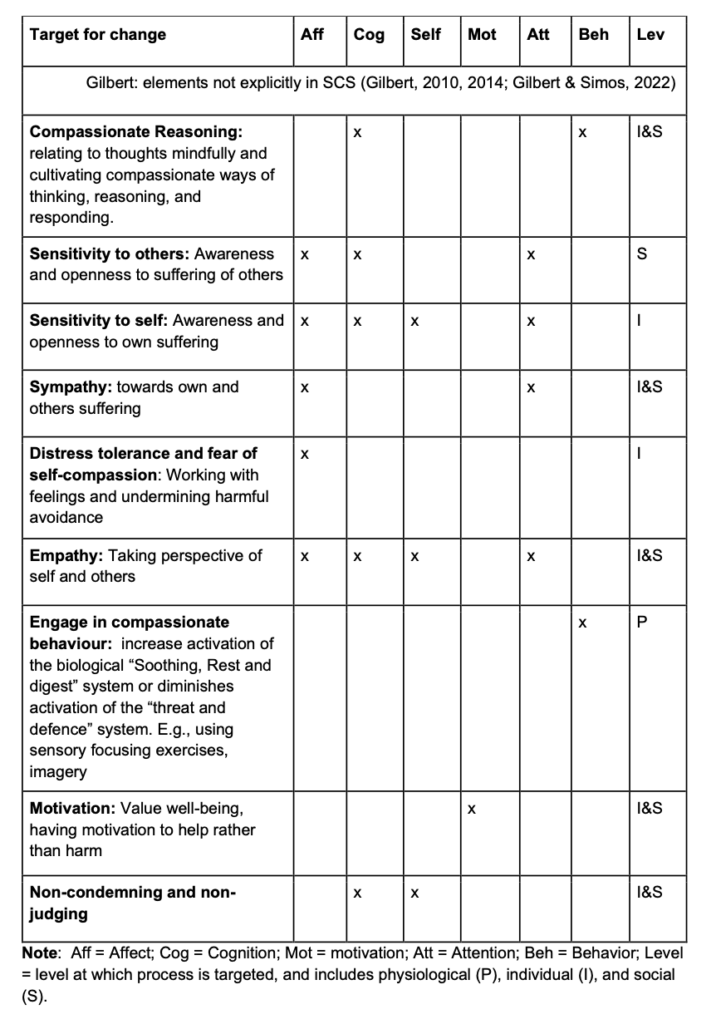You would be amazed at how much debate there is inside the self-compassion field. This article covers three aspects, from research to what you might do with clients:
- The controversy around self-compassion research
- How to understand process-based points of intervention
- How to build your intervention options

- What is self-compassion?
- How do we develop it?
- How does it influence well-being and engagement in valued activities?
The answer to the first “what is it” question will shape the answer to the second “how do we develop it question”. Neff (2003) defined self-compassion as involving several components:
1) Self-Kindness versus harsh Self-Criticism;
2) Seeing one’s suffering as part of the larger human experience (Common Humanity) rather than seeing the experiences as separating and Isolating;
3) Being Mindful and being able to hold painful thoughts and feelings in balanced awareness rather than overidentifying with them.
Let’s begin with the debate in the literature.
1. The great debate: What is self-compassion really?
If you are interested in the details of the debate, you can read this key scientific article, but here is a quick summary.
Position 1
Compassionate responding (the positive scales) and uncompassionate responding (the negative scales) are two sides of the same continuum, like hot and cold. If you are being patient and supportive of yourself (self-compassion), then you are less likely to be criticising yourself (self-criticism). This theory assumes that passion inhibits criticism.
Position 2 (ours)
Compassionate and uncompassionate responses are barely correlated, so they are unlikely to be a continuum. People can have a lot of self-criticism and self-compassion towards themselves during any day, sometimes during the same minute. For example, we might say to ourselves, “I am so stupid to have yelled at my son. I am a hopeless parent” and then in the next breath, say, “ but I guess I am imperfect like everybody else. I make mistakes. Next time I’ll do better. I don’t need to beat myself up.”
Other days people may engage in little selfing behavior, and have little self-compassionate or self-critical thinking. For example, they may lose themselves in nature and hardly think of themselves at all. This suggests that self-compassion and self-criticism can co-occur in any combination. We don’t think it is useful to think of self-compassion (“hot”) and self-criticism (“cold”) as one continuum since this misses the complexity of people and how they often have multiple conflicting voices.
2. Focusing on process
Rather than thinking of self-compassion as a thing, like a giraffe, you can think of it as a set of processes interacting with other processes. (you can read more about process-based therapy here). These processes may relate in different ways for different people. For example, below, we show two process networks taken from Ferrari et al. (2022). These are two hypothetical networks (shown below) but they illustrate how self-compassion might be experienced quite differently by different people.
Person A: Self-kindness and self-judgement only relate indirectly. If you wanted to increase self-kindness in this person, you would focus on mindfulness, and it might not change self-judgment.
Person B: has a strong direct link between self-kindness and self-judgement. So you focused on increasing self-kindness you’d likely reduce self-judgement too.

What processes are involved in self-compassion?
This is another one of those controversial questions we’ve created a hypothetical processes table to help you get an overview of the field. We have used our extended-evolutionary meta-model (EEMM) framework (Hayes et al. 2020) to classify processes into different dimensions (e.g., cognition, affect, etc) and different levels (physiological individual, social).
Table 1 classifies the key processes proposed in two major self-compassion theories (Gilbert, 2017; K. Neff, 2003). The purpose here is to present one classification of the processes, but we do not claim to have the “right” classification. That is open to discussion, something we hope the EEMM will facilitate. We have great respect for both Neff and Gilbert’s way of thinking.
Neff’s SCS: Appears to address affect, cognitive and self but not explicitly motivation, attention, and overt behavior. Further, the items focus on the individual and social level but not the physiological level. Finally, “mindfulness” items appear to focus on affect rather than attention.
Gilbert’s CFT: This seems to cut across all dimensions. For example, one process in the Gilbert model assesses why someone would want to engage in self-compassion in the first place (motivation). Gilbert also puts a heavier emphasis on biological systems, like the soothing system and the fight and flight system. Finally, Gilbert’s model emphasises the fear of self-compassion (Gilbert et al., 2011).


3. DNA-V as a clear way to build self-compassion interventions
DNA-V is a process-based approach to intervention (to learn about how the EEMM and DNA-V map to each other, you can read this). Table 2 presents one way of thinking about self-compassion processes.

The noticer plays a major role in self-compassion. High-skilled noticers can allow negative feelings and stress in their bodies without attacking via unhelpful defensive behavior. That is, by itself, being a “kind friend” to oneself. Just allowing ourselves to be as we are. What a good friend would do for us. We also need noticer skills to allow discomfort in the presence of other people’s suffering instead of avoiding that distress and avoiding empathy altogether.
All the other DNA-V skills are important too.


The valuer, for example, determines why we use self-compassion. We could use it in a non-valued way as an avoidance strategy. For example, imagine someone isn’t pulling their weight in a marriage. They are not helping with the kids and the housework. If this person, when the partner asks for support, says that they need to go to the pub to be compassionate towards themselves, this may destroy their relationship. What they are calling self-compassion leads to less value, not more. In DNA-V, self-compassion builds long-term value, not short-term gratification.
Discover is another important skill for self-compassion. Sometimes self-criticism is more comfortable than self-compassion. To treat ourselves with patience and kindness, we need to leave our comfort zone, give self-compassion a try and see what happens next. Does self-compassion make us lazy and useless, as some people think? Or does it make us more motivated to improve? We can test this out.
Finally, our advisor plays a critical role in self-compassion. Our advisor, or inner voice, will often have unhelpful rules to tell us, such as “self-compassion will make you weak” or “if I am suffering, there must be something wrong with me because nobody else seems to be suffering.” We need to watch out for thoughts like that, which, if believed, can lead to self-attacking.
Conclusion
Hopefully, this brief article has given you an idea of some of the hopes and controversies in the field of self-compassion. Despite the arguments and debates about self-compassion, we believe all the theories are converging on a simple idea:
Kindness is a much better form of motivation and energy than criticism.
References
Key articles
Ciarrochi, J., Ferrari, M., Guo, J., & Hayes, S. C. (2022, November 28). What is
Other sources
Gilbert, P. (2010). An Introduction to Compassion Focused Therapy in Cognitive Behavior Therapy. International Journal of Cognitive Therapy, 3(2), 97–112.
Gilbert, P. (2014). Compassion-focused therapy: Preface and introduction for special section. The British Journal of Clinical Psychology / the British Psychological Society, 53(1), 1–5.
Gilbert, P. (2017). A brief outline of the evolutionary approach for compassion focused therapy. Psychology and Psychiatry, 3, 218–227.
Gilbert, P., McEwan, K., Matos, M., & Rivis, A. (2011). Fears of compassion: development of three self-report measures. Psychology and Psychotherapy, 84(3), 239–255.
Gilbert, P., & Simos, G. (2022). Compassion Focused Therapy: Clinical Practice and Applications. Routledge.
Neff, K. (2003). Self-Compassion: An Alternative Conceptualization of a Healthy Attitude Toward Oneself. Self and Identity: The Journal of the International Society for Self and Identity, 2(2), 85–101.
Neff, K. D. (2003). The Development and Validation of a Scale to Measure Self-Compassion. Self and Identity: The Journal of the International Society for Self and Identity, 2(3), 223–250.

